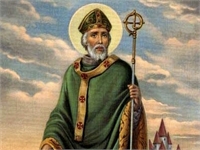
Who was St. Patrick?
Important Notice: Our web hosting provider recently started charging us for additional visits, which was unexpected. In response, we're seeking donations. Depending on the situation, we may explore different monetization options for our Community and Expert Contributors. It's crucial to provide more returns for their expertise and offer more Expert Validated Answers or AI Validated Answers. Learn more about our hosting issue here.
St. Patrick’s History: Early Life
St. Patrick, the patron saint of Ireland, was born in Bannauenta, Britain, in about the year 389 (although both his place and date of birth are often disputed). Son of Potitus, a middle-class deacon and minor local official, Patrick was no doubt raised a Christian, but showed little interest in religious studies until later in life.
At the age of 16, Patrick was captured by a band of Irish raiders, quite possibly while taking part in the raid against the Irish king Niall Noigiallach who met his end in Britain in 405. Taken to Ireland to be sold as a slave, Patrick served as shepherd to a chieftain named Miliucc for six years, near the mountain called Slemish in County Antrim (Ulster). During this bleak period of time, religion became Patrick’s solace and focus in life.
After receiving dream visions compelling him to escape, Patrick managed to break away from his captors and make his way some 200 miles to the coast of Wicklow (eastern Ireland), where he secured passage on a ship manned by Irish traders involved in exporting Irish wolf-dogs. After three days at sea, the traders landed at a desert (possibly on the west coast of Gaul, modern France and Belgium), across which they journeyed for 28 days without seeing another human being.
Parting ways, Patrick then made his way to the Abbey of Lérins on the island of Saint-Honorat on the French Riviera, where he stayed a few years before returning to his homeland. But all the while “the voice of the Irish,” as he called it, constantly haunted his thoughts and dreams.
He would later write in Confession, “I imagined that I heard in my mind the voice of those who were near the wood of Foclut, which is near the western sea, and thus they cried, ‘We pray thee, holy youth, to come and walk again amongst us as before.’” Patrick knew he had to return to his captors and convert them to Christianity.
To prepare himself for his mission, Patrick returned to Gaul to a place called Auxerre, where he studied religion under French bishop Saint Germanus for the next 14 years. Although Patrick was ordained a deacon, his superiors were reluctant to let him return to Ireland, considering his early education inadequate; many of his fellow clergymen even belittled him as illiterate. But when Palladius, the first Irish missionary bishop, died in 431, Pope Celestine decided to let Patrick go.
Return to Ireland
Patrick arrived in Ireland on March 25, 433, beginning his missionary work in the northern and western regions of pagan Ireland–areas no Christian had ever stepped foot.
Now nearly 45 years of age, Patrick faced the daily possibility of being slain or placed in chains. Although he was quickly befriended by several tribal chieftains, he also endured untold trials and hardships including imprisonment. Legend says that while one chieftain tried to kill Patrick, another, named Dichu, became an apostle after regaining use of a crippled arm after taking Patrick as a friend.
For the next 40 years, Patrick traveled the whole of Ireland, converting thousands of pagans to Christianity and acquiring many disciples. Kings, their families, and even entire kingdoms converted to Christianity upon hearing Patrick’s message. Patrick is said to have founded more than 300 churches, baptized more than 120,000 people, and worked many miracles during his missionary work in Ireland.
After years of living in virtual poverty Partick died at Saul in County Down in Northern Ireland, on March 17, 461, where he had built the first church.
Today, Irish Catholics throughout the world celebrate St. Patrick’s accomplishments on his feast day, March 17, now known world-wide as St. Patrick’s Day.
Legends
One of the best known and enduring legends surrounding St. Patrick’s history tells of his charming the snakes of Ireland, leading them into the sea to drown. (Today, this story is commonly thought to be a metaphor for ridding Ireland of the serpent symbolism common to the Druids of that time and place, or that it referred to Pelagianism, a controversial belief founded by Pelagius which was symbolized by serpents.)
Legend also credits St. Patrick with teaching the Irish the Catholic concept of the Trinity by showing followers a 3-leaved clover, using it to illustrate the Christian belief of “three divine persons in the one God,” the shamrock later becoming the traditional symbol of Ireland.